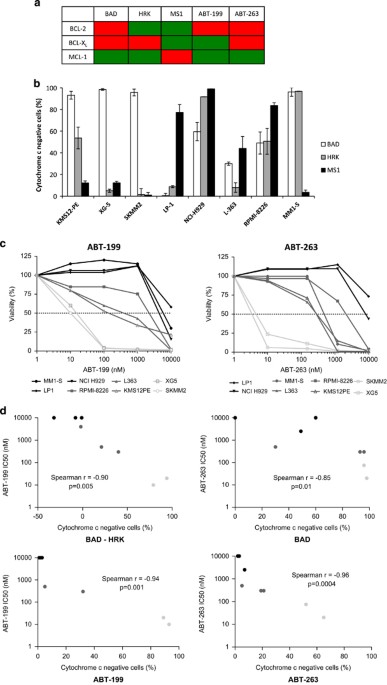
- Select a language for the TTS:
- UK English Female
- UK English Male
- US English Female
- US English Male
- Australian Female
- Australian Male
- Language selected: (auto detect) - EN
Play all audios:
Access through your institution Buy or subscribe Despite a significant improvement in the survival of patients with multiple myeloma (MM), the disease remains incurable and innovative
strategies are needed. Interactions among BCL-2 family proteins mainly determine cellular fate decision in response to drug therapy. Thus, anti-apoptotic members such as BCL-2, BCL-XL or
MCL-1 represent an attractive target for therapy.1 BH3 profiling is a functional assay that identifies the tumor cell’s addiction to these anti-apoptotic members.2 The oral BCL-2-specific
BH3 mimetic ABT-199 demonstrated very promising results in BCL-2-dependent malignancies such as chronic lymphoid leukemia and mantle cell lymphoma.3–5 To date, there has been no
determination of what proportion of MM cases are likely to be BCL-2 dependent. The present study demonstrated that MM is a heterogeneous disease with respect to BCL-2, BCL-XL or MCL-1
dependence. Moreover, identification by BH3 profiling of BCL-2 dependence predicted _in vitro_ sensitivity to BH3 mimetics. BH3 profiling is a unique, functional method to measure the
dependence to the anti-apoptotic proteins in live cancer cells. The present study demonstrates that MM is a heterogeneous disease regarding its dependence on anti-apoptotic proteins and
cannot be considered as monolithically BCL-2, BCL-XL or MCL-1 dependent. MCL-1 is expressed in MM cells at levels higher than normal plasma cells and its expression level has been shown to
affect clinical outcome.7, 8 Here, mitochondria from half of MM cell lines (4/8) and from almost one-third of primary samples (4/14) were found to be MCL-1 dependent. These results are
consistent with the requirement for MCL-1 for survival of many myeloma cells. BH3 profiling also identified a subset of BCL-2 and/or BCL-XL-dependent MM cells with relatively less dependence
on MCL-1 and correctly predicted sensitivity to the BH3 mimetics ABT-199 and 263. In our series, one MM cell line (MM1-S) and two primary samples (#7 and #11) were found to be sensitive to
ABT-263 but insensitive to ABT-199, that linked to their BCL-XL dependence determined using BH3 profiling. Even if these findings indicate that BCL-XL could be an attractive target for MM,
the BCL-XL-related platelet toxicity has impaired the clinical development of ABT-263.9 Previous studies identified MM cells sensitive to BH3 mimetics based on their BCL-2/MCL-1 mRNA
ratio10, 11 or interactions of BCL-XL and BCL-2 with BIM.12 From a practical point of view, BH3 profiling can be performed in just 3 h with fewer cells (5 × 104 plasma cells to determine
response to the BAD BH3 peptide). This consideration is of importance because bone marrow samples from MM patients usually contain a low percentage of plasma cells (the median percentage of
plasma cell in BM aspirate was 9% in our series). It has been previously reported that sensitivity to ABT-199 was restricted in MM patients with t(11;14) translocation.11 Here, among the
three ABT-199 sensitive samples, two were found to be t(11;14). By including previous data from Touzeau _et al._,11 sensitivity to ABT-199 from 29 different primary MM samples was analyzed.
Overall, seven samples (24%) were found to be sensitive to the drug (LD50<100 nM). Interestingly, six of these ABT-199 sensitive samples carried the t(11;14) translocation. Of note, the
remaining sensitive sample was found to be BCL-2 dependent according to BH3 profiling. Moreover, one sensitive patient sample was found to be negative for the t(11;14) translocation,
suggesting that BCL-2 dependence may exist beyond this cytogenetic subgroup. The positive and negative predictive values of BH3 profiling to predict ABT-199 sensitivity were 75% and 100%,
respectively (Supplementary Table). This is a preview of subscription content, access via your institution RELEVANT ARTICLES Open Access articles citing this article. * EFFICACY AND SAFETY
OF VENETOCLAX IN PATIENTS WITH RELAPSED/REFRACTORY MULTIPLE MYELOMA: A META-ANALYSIS * Xiaohui Gao * , Hui Zeng * … Fei Sun _BMC Cancer_ Open Access 03 November 2023 * EX VIVO DRUG RESPONSE
HETEROGENEITY REVEALS PERSONALIZED THERAPEUTIC STRATEGIES FOR PATIENTS WITH MULTIPLE MYELOMA * Klara Kropivsek * , Paul Kachel * … Berend Snijder _Nature Cancer_ Open Access 20 April 2023
* BH3 MIMETICS IN COMBINATION WITH NILOTINIB OR PONATINIB REPRESENT A PROMISING THERAPEUTIC STRATEGY IN BLAST PHASE CHRONIC MYELOID LEUKEMIA * Narissa Parry * , Caroline Busch * … Mhairi
Copland _Cell Death Discovery_ Open Access 15 November 2022 ACCESS OPTIONS Access through your institution Subscribe to this journal Receive 12 print issues and online access $259.00 per
year only $21.58 per issue Learn more Buy this article * Purchase on SpringerLink * Instant access to full article PDF Buy now Prices may be subject to local taxes which are calculated
during checkout ADDITIONAL ACCESS OPTIONS: * Log in * Learn about institutional subscriptions * Read our FAQs * Contact customer support REFERENCES * Letai AG . Diagnosing and exploiting
cancer’s addiction to blocks in apoptosis. _Nat Rev Cancer_ 2008; 8: 121–132. Article CAS Google Scholar * Certo M, Del Gaizo Moore V, Nishino M, Wei G, Korsmeyer S, Armstrong SA _et al_.
Mitochondria primed by death signals determine cellular addiction to antiapoptotic BCL-2 family members. _Cancer Cell_ 2006; 9: 351–365. Article CAS Google Scholar * BCL-2 inhibitor
yields high response in CLL and SLL. _Cancer Discov_ 2014; 4: OF5. * Davids MS, Roberts AW, Anderson MA, Pagel JM, Kahl BS, Gerecitano JF _et al_. The BCL-2-specific BH3-mimetic ABT-199
(GDC-0199) Is active and well-tolerated in patients with relapsed Non-Hodgkin lymphoma: interim results of a Phase I study. _ASH Annu Meet Abstr_ 2012; 120: 304. Google Scholar * Souers AJ,
Leverson JD, Boghaert ER, Ackler SL, Catron ND, Chen J _et al_. ABT-199, a potent and selective BCL-2 inhibitor, achieves antitumor activity while sparing platelets. _Nat Med_ 2013; 19:
202–208. Article CAS Google Scholar * Foight GW, Ryan JA, Gullá SV, Letai A, Keating AE . Designed BH3 peptides with high affinity and specificity for targeting Mcl-1 in cells. _ACS Chem
Biol_ 2014; 9: 1962–1968. Article CAS Google Scholar * Munshi NC, Hideshima T, Carrasco D, Shammas M, Auclair D, Davies F _et al_. Identification of genes modulated in multiple myeloma
using genetically identical twin samples. _Blood_ 2004; 103: 1799–1806. Article CAS Google Scholar * Wuillème-Toumi S, Robillard N, Gomez P, Moreau P, Le Gouill S, Avet-Loiseau H _et al_.
Mcl-1 is overexpressed in multiple myeloma and associated with relapse and shorter survival. _Leukemia_ 2005; 19: 1248–1252. Article Google Scholar * Roberts AW, Seymour JF, Brown JR,
Wierda WG, Kipps TJ, Khaw SL _et al_. Substantial susceptibility of chronic lymphocytic leukemia to BCL2 inhibition: results of a phase I study of navitoclax in patients with relapsed or
refractory disease. _J Clin Oncol Off J Am Soc Clin Oncol_ 2012; 30: 488–496. Article CAS Google Scholar * Bodet L, Gomez-Bougie P, Touzeau C, Dousset C, Descamps G, Maïga S _et al_.
ABT-737 is highly effective against molecular subgroups of multiple myeloma. _Blood_ 2011; 118: 3901–3910. Article CAS Google Scholar * Touzeau C, Dousset C, Le Gouill S, Sampath D,
Leverson JD, Souers AJ _et al_. The Bcl-2 specific BH3 mimetic ABT-199: a promising targeted therapy for t(11;14) multiple myeloma. _Leukemia_ 2013; 28: 210–212. Article Google Scholar *
Morales AA, Kurtoglu M, Matulis SM, Liu J, Siefker D, Gutman DM _et al_. Distribution of Bim determines Mcl-1 dependence or codependence with Bcl-xL/Bcl-2 in Mcl-1-expressing myeloma cells.
_Blood_ 2011; 118: 1329–1339. Article CAS Google Scholar * Pan R, Hogdal LJ, Benito JM, Bucci D, Han L, Borthakur G _et al_. Selective BCL-2 inhibition by ABT-199 causes on-target cell
death in acute myeloid leukemia. _Cancer Discov_ 2014; 4: 362–375. Article CAS Google Scholar * Chonghaile TN, Roderick JE, Glenfield C, Ryan J, Sallan SE, Silverman LB _et al_.
Maturation stage of T-cell acute lymphoblastic leukemia determines BCL-2 versus BCL-XL dependence and sensitivity to ABT-199. _Cancer Discov_ 2014; 4: 1074–1087. Article CAS Google Scholar
* Kumar S, Vij R, Kaufman J, Mikhael J, Facon T, Moreau P _et al_Phase I Interim Safety and Efficacy of Venetoclax (ABT-199/GDC-0199) Monotherapy for Relapsed/refractory Multiple Myeloma.
_J Clin Oncol_ 2015; 33 (suppl: abstract 8576).. * Touzeau C, Chanan-Khan A, Roberts AW, Agarwal A, Facon T, Lebovic D _et al_Phase 1b Interim Results: Venetoclax (ABT-199/GDC-0199) in
Combination with Bortezomib and Dexamethasone in Relapsed/Refractory Multiple Myeloma. _J Clin Oncol_ 2015; 33 (suppl): abstract 8580.. * Ryan J, Letai A . BH3 profiling in whole cells by
fluorimeter or FACS. _Methods_ 2013; 61: 156–164. Article CAS Google Scholar Download references ACKNOWLEDGEMENTS We gratefully acknowledge support from NIH grants R01CA129974. CT was
supported by the Fondation Française pour la Recherche contre le Myélome et les Gammapathies monoclonales (F.F.R.M.G.). AUTHOR CONTRIBUTIONS AL and CT designed the research and wrote the
manuscript. CT performed the experiments. CT, AL, JR, TNC analyzed the data. PR, KA, MA, SLG and PM provided myeloma cells. All the authors critically reviewed the manuscript. AUTHOR
INFORMATION AUTHORS AND AFFILIATIONS * Department of Medical Oncology, Dana-Farber Cancer Institute, Boston, MA, USA C Touzeau, J Ryan, J Guerriero, P Richardson, K Anderson & A Letai *
Department of Hematology, University hospital, Nantes, France C Touzeau, P Moreau & S Le Gouill * INSERM UMR892, CNRS UMR6299, University of Nantes, Nantes, France C Touzeau, P Moreau, S
Le Gouill & M Amiot * Conway Institute of Biomolecular and Biomedical Research, Dublin, Ireland T N Chonghaile Authors * C Touzeau View author publications You can also search for this
author inPubMed Google Scholar * J Ryan View author publications You can also search for this author inPubMed Google Scholar * J Guerriero View author publications You can also search for
this author inPubMed Google Scholar * P Moreau View author publications You can also search for this author inPubMed Google Scholar * T N Chonghaile View author publications You can also
search for this author inPubMed Google Scholar * S Le Gouill View author publications You can also search for this author inPubMed Google Scholar * P Richardson View author publications You
can also search for this author inPubMed Google Scholar * K Anderson View author publications You can also search for this author inPubMed Google Scholar * M Amiot View author publications
You can also search for this author inPubMed Google Scholar * A Letai View author publications You can also search for this author inPubMed Google Scholar CORRESPONDING AUTHOR Correspondence
to A Letai. ETHICS DECLARATIONS COMPETING INTERESTS AL has been a paid advisor to AbbVie. AL’s laboratory has received sponsorship for research with AbbVie. ADDITIONAL INFORMATION
Supplementary Information accompanies this paper on the Leukemia website SUPPLEMENTARY INFORMATION SUPPLEMENTARY TABLE (PPT 151 KB) RIGHTS AND PERMISSIONS Reprints and permissions ABOUT THIS
ARTICLE CITE THIS ARTICLE Touzeau, C., Ryan, J., Guerriero, J. _et al._ BH3 profiling identifies heterogeneous dependency on Bcl-2 family members in multiple myeloma and predicts
sensitivity to BH3 mimetics. _Leukemia_ 30, 761–764 (2016). https://doi.org/10.1038/leu.2015.184 Download citation * Published: 15 July 2015 * Issue Date: March 2016 * DOI:
https://doi.org/10.1038/leu.2015.184 SHARE THIS ARTICLE Anyone you share the following link with will be able to read this content: Get shareable link Sorry, a shareable link is not
currently available for this article. Copy to clipboard Provided by the Springer Nature SharedIt content-sharing initiative






